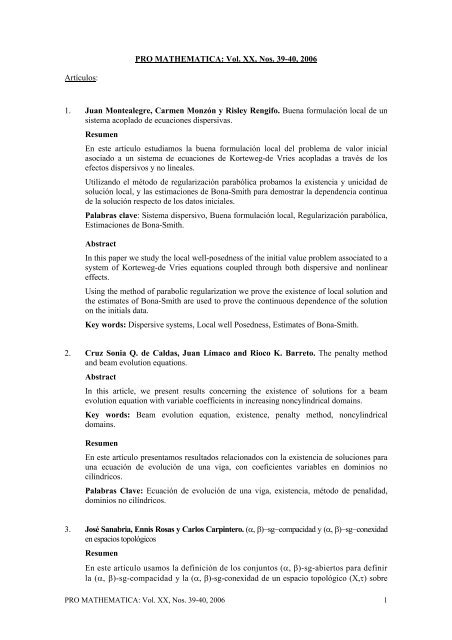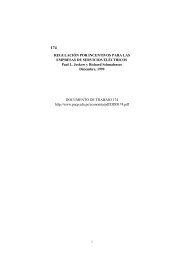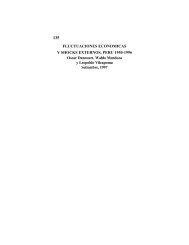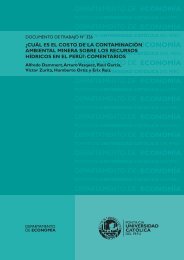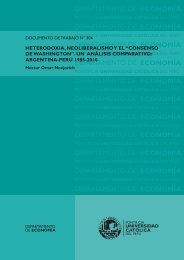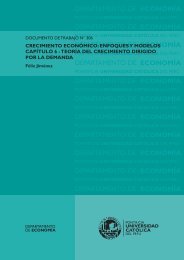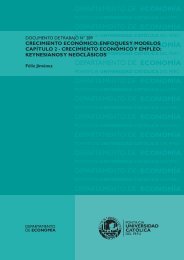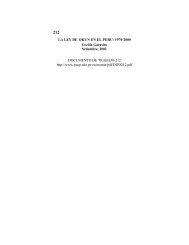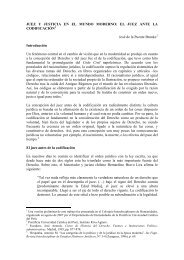PRO MATHEMATICA: Vol. XX, Nos. 39-40, 2006 ArtÃculos: 1. Juan ...
PRO MATHEMATICA: Vol. XX, Nos. 39-40, 2006 ArtÃculos: 1. Juan ...
PRO MATHEMATICA: Vol. XX, Nos. 39-40, 2006 ArtÃculos: 1. Juan ...
- No tags were found...
Create successful ePaper yourself
Turn your PDF publications into a flip-book with our unique Google optimized e-Paper software.
<strong>PRO</strong> <strong>MATHEMATICA</strong>: <strong>Vol</strong>. <strong>XX</strong>, <strong>Nos</strong>. <strong>39</strong>-<strong>40</strong>, <strong>2006</strong>Artículos:<strong>1.</strong> <strong>Juan</strong> Montealegre, Carmen Monzón y Risley Rengifo. Buena formulación local de unsistema acoplado de ecuaciones dispersivas.ResumenEn este artículo estudiamos la buena formulación local del problema de valor inicialasociado a un sistema de ecuaciones de Korteweg-de Vries acopladas a través de losefectos dispersivos y no lineales.Utilizando el método de regularización parabólica probamos la existencia y unicidad desolución local, y las estimaciones de Bona-Smith para demostrar la dependencia continuade la solución respecto de los datos iniciales.Palabras clave: Sistema dispersivo, Buena formulación local, Regularización parabólica,Estimaciones de Bona-Smith.AbstractIn this paper we study the local well-posedness of the initial value problem associated to asystem of Korteweg-de Vries equations coupled through both dispersive and nonlineareffects.Using the method of parabolic regularization we prove the existence of local solution andthe estimates of Bona-Smith are used to prove the continuous dependence of the solutionon the initials data.Key words: Dispersive systems, Local well Posedness, Estimates of Bona-Smith.2. Cruz Sonia Q. de Caldas, <strong>Juan</strong> Límaco and Rioco K. Barreto. The penalty methodand beam evolution equations.AbstractIn this article, we present results concerning the existence of solutions for a beamevolution equation with variable coefficients in increasing noncylindrical domains.Key words: Beam evolution equation, existence, penalty method, noncylindricaldomains.ResumenEn este artículo presentamos resultados relacionados con la existencia de soluciones parauna ecuación de evolución de una viga, con coeficientes variables en dominios nocilíndricos.Palabras Clave: Ecuación de evolución de una viga, existencia, método de penalidad,dominios no cilíndricos.3. José Sanabria, Ennis Rosas y Carlos Carpintero. (α, β)−sg−compacidad y (α, β)−sg−conexidaden espacios topológicosResumenEn este artículo usamos la definición de los conjuntos (α, β)-sg-abiertos para definirla (α, β)-sg-compacidad y la (α, β)-sg-conexidad de un espacio topológico (X,τ) sobre<strong>PRO</strong> <strong>MATHEMATICA</strong>: <strong>Vol</strong>. <strong>XX</strong>, <strong>Nos</strong>. <strong>39</strong>-<strong>40</strong>, <strong>2006</strong> 1
el cual se tienen operadores α, β asociados a τ. Se estudian y se caracterizan los espacios(α, β)-sg-compactos y los espacios (α, β)-sg-conexos, además buscamos condiciones bajoel cual se preserva la imagen de espacios (α, β)-sg-compactos y (α, β)-sg-conexosmediante funciones.Palabras Clave: (α, β)-sg-abierto, (α, β)-sg-compacto, (α, β)-sg-conexo.AbstractIn this paper we used the definition of (α, β)-sg-open sets in order to define the (α, β)-sgcompactsets and (α, β)-sg-connected sets in a topological space (X, τ). Also we studysome properties of the (α, β)-sg-compact spaces and the (α, β)-sg-connected spaces. Alsowe looking for conditions under what the image of (α, β)-sg-compact sets and (α, β)-sgconnectedsets are preserved under functions.Key words: (α, β)-sg-open, (α, β)-sg-compact, (α, β)-sg-connected.4. Mumtaz Ahmad Khan and Bijan Rouhi. A study on a calculus for the T k,x, y, z −operator.AbstractThe present paper deals with the calculus of T k,x, y, z −operator. The operator is a threevariable analogue of the operator given earlier by W. A. Al-Salam [1] and H. B. Mittal[10]. The operator is useful for finding operational representations and generatingfunctions of polynomials of three variables and will be dealt in a separate communication.Key words: Differential operators, special functions, generating functions.ResumenEl presente artículo trata del cálculo del operador T k,x, y, z . Este operador de tres variableses análogo al operador dado por W.A. Al-Salam [1] y H. B. Mittal [10]. El operador esútil para hallar representaciones operativas y para funciones generatrices de polinomios detres variables las que serán tratadas en una comunicación aparte.Palabras Clave: Operadores diferenciales, funciones especiales, funciones generatrices.5. Christian Figueroa. Inmersiones mínimas y aplicaciones armónicas.ResumenLa teoría de las superficies mínimas y en general las inmersiones mínimas es un temamuy atrayente en el que se realiza un intenso trabajo de investigación dentro de laGeometría Diferencial. Desde los inicios de esta teoría se pudo notar la relación entre lapropiedad de minimalidad y las aplicaciones armónicas. En los inicios E. Beltramiestablece que una superficie en — 3 es mínima si sus componentes son funcionesarmónicas. Hasta llegar a nuestros días donde Eells-Sampson establece que una inmersiónisométrica es mínima si tal aplicación es armónica.Palabras Clave: Superficies mínimas, aplicaciones armónicas, problema variacional.AbstractThe theory of the minimal surfaces and in general minimal immersions is a very attractivesubject in which an intense work of investigation is made. From the beginnings of thistheory the relation between the harmonic applications and this type of immersions couldbe noticed. Beltrami establishes that a surface in — 3 is minimal if their components are<strong>PRO</strong> <strong>MATHEMATICA</strong>: <strong>Vol</strong>. <strong>XX</strong>, <strong>Nos</strong>. <strong>39</strong>-<strong>40</strong>, <strong>2006</strong> 2
harmonic. This situation is generalized by Eells-Sampson, who establishes that anisometric immersion is minimal if such application is harmonic.Key words: Minimal surfaces, harmonic applications, Variational problem.6. Lolimar Díaz and Raúl Naulin. A set of almost periodic discontinuous functions.AbstractIn this paper the non density of AP, the set of almost periodic functions in the sense ofBohr, in the space S of almost periodic functions in the sense of Stepanov is proven.Key words: Bohr and Stepanov almost periodic functions; almost periodic sequences.ResumenEn este artículo se demuestra que AP, el conjunto de las funciones casi periódicas segúnBohr, no es denso en S, el espacio de las funciones casi periódicas según Stepanov.Palabras clave: Casi periodicidad en el sentido de Bohr y en el sentido de Stepanov;funciones y sucesiones casi periódicas.7. Miguel Caldas, Erdal Ekici and Saeid Jafari. On λ−closure spaces.AbstractIn this paper, we show that a pointwise λ-symmetric λ-isotonic λ-closure function isuniquely determined by the pairs of sets it separates. We then show that when the λ-closure function of the domain is λ-isotonic and the λ-closure function of the codomain isλ-isotonic and pointwise-λ-symmetric, functions which separate only those pairs of setswhich are already separated are λ-continuous.Key words: Pointwise λ-closed sets, λ-closure function, λ-continuous functions.ResumenEn este artículo, demostramos que una función puntualmente λ simétrica, λ-isotónica, λ-clausurada es determinada únicamente por los pares de conjuntos que ella separa. Luegoprobamos que, cuando la función λ-clausurada del dominio es λ-isotónica y la función λ-clausurada del codominio es λ-isotónica y puntualmente λ-simétrica, las funciones queseparan solamente aquellos pares de conjuntos que están ya separados son λ-continuas.Palabras Clave: Conjuntos puntualmente λ-clausurados, función λ-clausurada, funcionesλ-continuas.8. Alexander Peña Bottcher. Dos teoremas clásicos de la teoría de homotopíaResumenEn el presente artículo se demostrará la conmutatividad de los grupos de homotopíasuperior y que toda equivalencia de homotopía es una equivalencia débil. Estamos en lacategoría Top, por lo tanto todo morfismo entre espacios será asumido una funcióncontinua y todo producto entre espacios tendrá la topología producto.Palabras Clave: Topología, Topología Algebraica, Homotopía.<strong>PRO</strong> <strong>MATHEMATICA</strong>: <strong>Vol</strong>. <strong>XX</strong>, <strong>Nos</strong>. <strong>39</strong>-<strong>40</strong>, <strong>2006</strong> 3
AbstractIn this paper we prove the commutativity of π n for n ≤ 2 and that all homotopyequivalence is a weak equivalence. We are in the cathegory Top, therefore all morfismsare assumed continuous and all spaces product will have the product topology.Key words: Topology, Algebraic Topology, Homotopy.9. Omar Rivasplata, Jan Rychtář and Christian Sykes. Evolutionary games in finitepopulationsAbstractThe classical replicator dynamics for evolutionary games in infinite populationsformulated by Taylor and Jonker is invariant when all the payoff values are shifted by aconstant. We demonstrate that this is not the case in finite populations. We show that bothdeterministic and stochastic evolutionary game dynamics based on the original model ofTaylor and Jonker depend on the actual payoff values. We present a variant of MaynardSmith's evolutionary stability criteria for finite populations that are large (and possibly ofunknown size). We give a full description for the case of a two strategy game. Our maincontribution is a statement that an evolutionarily stable strategy as originally defined byMaynard Smith still works for large populations provided that it does well against itself.Key words: Evolutionary Stability, ESS, Finite populations, Game dynamics.ResumenEl modelo clásico de dinámica replicadora formulado por Taylor y Jonker para juegosevolucionarios en poblaciones infinitas es invariante cuando los valores de la matriz depagos se trasladan por una constante. Demostraremos que este no es el caso enpoblaciones finitas. Demostraremos que las dinámicas determinística y estocástica parajuegos evolucionarios, basadas en el modelo original de Taylor y Jonker, ambas dependende los valores de la matriz de pagos. Presentaremos una variante del criterio de estabilidadevolucionaria propuesto por Maynard Smith para poblaciones finitas de gran tamaño(pero posiblemente desconocido). Daremos una descripción completa en el caso de juegoscon dos estrategias. Nuestra contribución principal establece que una estrategiaevolucionariamente estable, cual definida originalmente por Maynard Smith, siguesiéndolo en poblaciones finitas de gran tamaño, bajo condición de que dicha estrategiafuncione bien en interacciones consigo misma.Palabras Clave: Estabilidad evolucionaria, estrategias evolucionariamente estables,poblaciones finitas, dinámica evolucionaria.<strong>PRO</strong> <strong>MATHEMATICA</strong>: <strong>Vol</strong>. <strong>XX</strong>, <strong>Nos</strong>. <strong>39</strong>-<strong>40</strong>, <strong>2006</strong> 4


